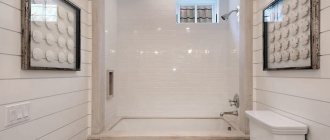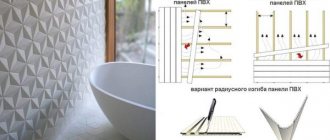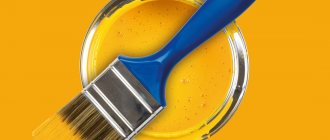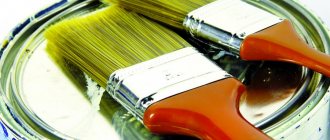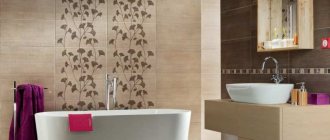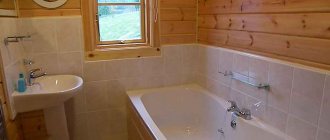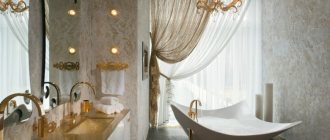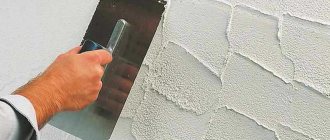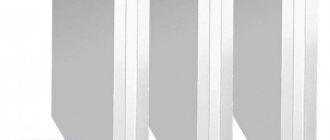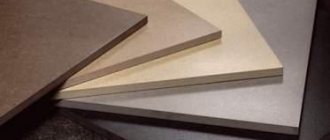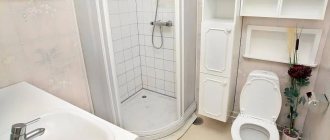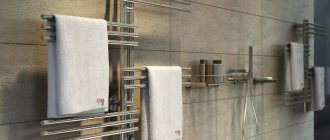The process of repairing wall coverings involves preparing the walls in the bathroom for painting. This stage of repair consists of plastering the walls in the room. Putty is needed so that the paint sticks well to the wall and does not peel or peel. This article will tell you how to choose putty for a bathroom for painting, as well as the process of puttying wall coverings indoors.
The quality of the mixture and its purpose
The putty mixture has a high degree of grain, so it must be thoroughly mixed before starting the application procedure.
And the surface itself, after puttying, is treated with abrasive materials. Due to the fact that the granular consistency of the mixture cannot be eliminated. When painting is applied without treating the plastered surface, all roughness and irregularities will be clearly visible.
A surface treated with putty can be covered with wallpaper, but such treatment is not suitable for a bathroom due to the high exposure to moisture in the room. To simplify the process of applying paint to the wall, manufacturers began to produce fine-grained materials.
The best tool for applying base paint is a spatula. Under the influence of this spatula, you can feel all the imperfections of the wall covering.
It is better for the putty to dry naturally. Artificial drying is not recommended. Rapid drying leads to shrinkage and the appearance of seams or cracks in the coating, which will ruin the appearance even before paint is applied. And you will have to putty the walls in the bathroom again.
Types of composition
There are several classifications based on the types of putty mixtures.
According to the degree of readiness, they are distinguished:
- dry solutions;
- ready-made solutions.
In accordance with the purpose, the following are distinguished:
- putty made of polymeric materials;
- cement-based mortars;
- gypsum materials.
Each type has both advantages and disadvantages.
Mixtures for plastering on beacons based on cement are resistant to moisture. The quality of the mixture is not affected by the level of humidity in the room.
We recommend reading: Finishing bathroom walls in 1 day with plastic panels - video instructions
Experts recommend just such solutions for bathroom renovations. In addition, the price of such a mixture is low, which is an advantage for self-repairs.
But, despite all the advantages, the cement mixture has a significant drawback for beginners in repair - it has a structure with frequent and large grains.
If the owner of the apartment plans to make the room light, then you cannot use such a base for paint, since the dried putty has a gray color.
Another disadvantage of cement material is its tendency to shrink. It must be applied in several layers, and each layer must be processed after drying.
Bathroom putty for painting is also produced on the basis of modern material - polymer . Its advantage is that it produces a polymerization process upon contact with the air, which results in the formation of a perfectly flat surface. This mixture does not dry out for a long time, so the filling process can be delayed.
But there is one drawback - the ability of modern components to cause allergies. Therefore, even if the person carrying out the repairs is not prone to allergies, he should consider protection in the form of a respirator.
Gypsum materials are suitable for light paint colors, as they are presented in light powder. This type of putty is applied in an even layer and dries quickly. But it has a huge disadvantage - exposure to temperature, so it is not suitable for use in the bathroom.
Rules for puttying surfaces in the bathroom
You can’t just apply the mixture to the walls and smooth it out. There is a whole range of activities that precede such work. Any surface, even if it seems ideal, needs preliminary preparation.
Preparatory stage
This event is as follows:
- Completely remove the previously applied coating. They widen the cracks that will be sealed first.
- Protruding objects - screws, mortgages - are knocked down using improvised tools.
- Use a rag soaked in water to remove dust and dirt.
Oily areas are treated with soap solution and turpentine. High humidity and temperature have a beneficial effect on the appearance of fungus and mold, therefore:
- All damaged areas are completely cleaned.
- If there are traces of the appearance of such phenomena, then they are additionally burned with a blowtorch.
- The antiseptic works well on all surfaces; attention should be paid to joints and seams.
After waiting for it to dry, proceed to another stage. This is a mandatory event and consists of the following:
- A solution with deep penetration is selected. It is better to give preference to a primer that contains an antiseptic.
- Applying the primer does not require any special skills; you can use a spray bottle.
Before proceeding with the main actions, you should wait until the applied layer has completely dried.
Advice! It happens that large cracks or holes are found between the seams on the walls or ceiling. They are sealed using cement plaster. Although this work can be simplified a little, for this purpose they use polyurethane foam. It seals large damage well and does not require much effort to apply.
Puttying
Putty for the bathroom must contain the inscription on the packaging - suitable for wet rooms, and also belong to one of the types listed above. Thus, we can say that the main condition will be achieved a priori. Namely, the mixture will have the necessary qualities. But now another problem arises; it needs to be applied correctly.
It is especially difficult when surfaces are supposed to be painted. The fact is that the paint immediately detects and highlights all existing defects.
Determine the required number of layers. If the work is carried out on already applied plaster, then you can limit yourself to the finishing mixture. When there are significant unevennesses that require applying a solution one centimeter thick, then they resort to starting putties.
- Pour the required amount of the composition into the container, add water little by little, constantly stirring with a drill with a mixer attachment.
- You need to obtain a paste-like consistency, which is left for 10 minutes. This is done to ensure that all additives are completely dissolved. After this, stirring is repeated.
Damp rooms require the most careful attention. If you approach their finishing superficially, it turns out that very soon fungi and mold will begin to appear, the layer will simply collapse. It’s better to spend a little more time on this, but forget about the problems for many decades.
Types of polymer compositions
Polymer compositions are the newest and most modern type of putty, which is in high demand in the construction market. Among the varieties of such solutions, acrylic and latex mixtures are distinguished.
Both types have a large number of advantages. For example, they are able to organize a perfectly even coating, while at the same time being able to fill in unevenness in the wall.
The advantage of acrylic mixtures over latex ones is that they are odorless and do not cause allergies. In turn, latex compositions are suitable for all types of building materials.
We recommend reading: Wall decoration: in the bedroom, living room, kitchen
Can tiles be laid on drywall? What is needed for this?
It may seem to many that tile and drywall are two incompatible materials. Especially in areas where tiles are usually installed - bathrooms, toilets and wet areas. This is not entirely true, let’s look at the conditions under which you can glue tiles onto a plasterboard base.
Why do they do this?
The logical question is, why put tiles on drywall at all? The main reason is large differences in the level of the “rough” wall. If finishing is carried out according to the standard scheme, then the surface is first plastered, and then the tiles are glued. If the difference on the wall is more than 5 - 8 cm, then a too thick layer of plaster will be required.
In this case, they resort to using plasterboard; it allows you to get a flat surface for the tiles without plastering the problem wall. But you can’t just lay tiles on drywall; it’s important to adhere to certain requirements.
Special drywall.
Laying tiles refers to “wet” types of finishing, because laying is carried out with the participation of water. Moisture is the weak point of conventional drywall (GKL), so it is better to use moisture-resistant plasterboard (GKLV) under the tiles.
Durable frame
Drywall is attached to a frame made of profiles. Since the tile creates an increased load, you should give preference to a thick profile (0.6 mm). A thin profile (0.3 mm) for the weight of the tile cladding will not provide the necessary rigidity.
What tile adhesive
The main feature of drywall is that it is subject to temperature deformation, while tile, on the contrary, is dense and does not deform. The tile adhesive must compensate for the deformation of the base, so the composition for gluing the tiles must have the necessary elasticity.
Elastic compounds according to GOST are designated by the Latin letter S; there are two elasticity classes S1 and S2. For tiles of standard sizes (20x20, 20x30 cm) S1 is sufficient. For large-format tiles (more than 80 cm), it is better to use adhesive with elasticity S2. The adhesion class must be at least C1.
There is an article on our channel about choosing glue according to GOST standards (link at the end).
Also suitable for gluing tiles is a two-component tile adhesive; it consists of a hardener and polyester, which are mixed before starting work. The disadvantage of such compositions is rapid hardening. This makes it difficult to align already glued tiles.
Liquid nails and silicone sealant can also be used to glue tiles to drywall; they are elastic and have high adhesion. However, the costs when using sealant or nails will be higher than when working with glue. This option is good if you need to glue a small number of tiles.
Is it necessary to putty drywall under tiles?
On the Internet you can find a statement that drywall must be completely puttied under the tiles. This is a misconception; only the joints of plasterboard sheets need to be puttied.
Read the article about processing drywall joints on our channel (link at the end)
But there are exceptions, when the tiling is done locally, and the rest of the wall is to be painted (For example, a tiled apron in the kitchen). In this case, the drywall is puttied, as for painting or wallpapering.
How to prime drywall before laying tiles?
An important procedure before laying tiles is applying a primer. It is better to use specialized compounds for laying tiles on drywall. The soil must have moisture-insulating properties to reduce the loss of moisture into the drywall sheets.
Material requirements
The putty mixture used to process the wall covering must meet a number of characteristics.
- Moisture resistance.
This characteristic means that the putty material should not change its properties during operation. High quality is characterized by the fact that wet exposure does not harm the coating and bonds the base and paint together.
- Long service life.
A good putty material, properly selected and applied, can withstand a service life of up to twenty years.
- Temperature resistance.
Sometimes sudden temperature changes occur in the bathroom, causing the coating to deteriorate. Materials for wall treatment should not be exposed to high and low temperatures. In addition, the process of polymerization of putty substances can ruin the entire job due to temperature effects. Therefore, you should ask specialized stores for putty mixtures that can maintain adhesive properties when exposed to temperature.
- Protection against fungus and mold.
Putty is the basis for paint, and its task is to prevent the development of fungus, mold, and dark spots on the decorative wall covering.
- No porosity.
The putty mixture should be as homogeneous as possible, because if bubbles appear on the surface due to the porosity of the material, then when painting these irregularities will be clearly visible.
- High possibility of wetting.
This property is necessary so that the layer of the mixture when applied is as thin as possible.
Padding
The next step is priming the drywall. Thanks to the primer, the surface will adhere better to the putty. You can do without a primer, but in this case the putty may peel off along with the tile. The primer composition is applied with a wide brush or roller.
Note! On the packaging, the manufacturer provides instructions for using the primer.
A good primer should have the following set of qualities:
- The composition must penetrate deeply into the material.
- Good adhesion, which is the key to the durability of the repair.
- Absence of toxic substances.
- Ability to bind dust.
- Quick drying.
- Thermal stability.
- Ability to withstand the effects of humidity.
- The presence of an antiseptic drug that prevents the development of mold and mildew.
What tools are needed?
Puttying begins with preparing the necessary tools and materials. This is necessary so that the process of covering the wall with a paint base goes on non-stop and is not interrupted by trips to the store to buy additional products.
Recommended reading: How to professionally paint bathroom walls
Of course, the process of treating a wall is impossible without putty. You will need:
- basecoat and topcoat;
- three types of spatulas necessary for plastering walls, wide, narrow and angular;
- sandpaper or a special mesh for sanding.
- primer mixture and a roller with which it is applied to the wall.
- You will also need to carry out repair work using a hammer drill.
The main advantage of putty is the application of a minimally thin layer of finishing material, unlike most other dry mixtures. As for the variety of this product, the choice is simply huge.
What you need to know when purchasing is the types into which it is divided:
- KR – ordinary putty;
- VH is a putty designed specifically for rooms with high humidity. This type of putty is best suited for the bathroom.
